
There is a lot of debate over this one question: what do cats hunt for in the wild?
Make no mistake, outdoor cats who hunt definitely have some impact as they are invasive to many areas.
It is always best to keep your pet cats indoors with only supervised visits outside. Not only does hunting carry parasite risks, but it also carries injury risks, and the fewer wildlife killed, the better.
It’s a heated subject thanks to wildlife conservationists believing one or two studies based on owner surveys about pet cats with outdoor access killing billions of birds in the US.
The fact is no one actually understands what impact outdoor cats have on any ecosystem except islands. This is because there are so many factors affecting birds and most mainland ecosystems are not as simple or isolated as island ecosystems.
In some instances – especially on islands – the belief that feral cats are harmful has led to their eradication by well-meaning conservationists. Yes, this means they were killed. In some instances, the bird population rebounded after the feral cats were destroyed. In others, rats and other rodents decimated the bird and/or plant life on the island after cats were no longer around to control their population.
I do know that cats are claimed to kill over 30% of the total bird population in North America each year in the US alone. All birds would have been wiped out by now if cats were as serious of predation risk as those numbers claim.
However, the sheer number of free-roaming cats DO have a negative impact on the environment so it’s up to ALL of us to spay and neuter our pets, keep our pet cats indoors, and fix any unowned or feral cat outside! Bonus points if you take in feral or stray kittens and any friendly strays to be adopted into safe, indoor homes!
In fact, the total population of birds in North America is concerning because it’s dropped 29% in the last 50 years according to a New York Times article.
What are the main culprits? According to the NYT article:
“There are likely many causes, the most important of which include habitat loss and wider use of pesticides.”
But let’s talk about what the domestic cat hunts, shall we? The main source of my cat hunting knowledge is The Domestic Cat: The Biology of Its Behaviour by Dennis C. Turner and Patrick Bateson. This particular text on cat behavior includes almost all reputable studies on cats up to the year 2000. Plus my experience, of course.
Disclaimer: This post contains affiliate links. I may earn a small commission from qualifying purchases, at no cost to you. Read the Affiliate Disclosure for full details.
- The Domestic Cat is an Obligate Carnivore
- Domestic Cats Do More Than Hunt Mice
- How Do Cats Hunt?
- After a Successful Hunt
- Why Do Cats Play With Their Prey?
- Cats Prefer Some Prey to Others!
- When Do Cats Hunt?
- Where Do Cats Hunt?
- Continental vs. Island Felines
- Effects of Cat Predation on Prey Populations
- Arguments Against Cat Predation Studies
- Suggestions that do NOT Reduce Cat Predation
- Do You Want to Help Reduce Cat Predation?
The Domestic Cat is an Obligate Carnivore
The domestic cat is a species of cat believed to be descended from the African Wildcat (felis silvestris lybica). If you want to get technical, the domestic cat species name is Felis catus. Matings between the domestic cat and the African Wildcat are common, even today.
Like their large, wild cousins, cats are carnivores. To be more specific, cats are obligate carnivores. This means they absolutely have to have a diet consisting of meat, meat, and more meat.
The domestic cat has no known need for carbohydrates or vegetables as they lack the enzyme to digest plant matter properly. Even plant protein. The cat has a high protein requirement and it must all come from meat.
This does NOT mean cats cannot eat plants or that it’s harmful for them to eat plants!
Have you ever seen a cat eat grass? Well, they aren’t doing it because they get vitamins or minerals out of it. It is not proven why they do this, but there are a few theories. All theories revolve around helping their digestive tract, either by helping the kitty to throw up or helping the kitty poop well. It is also suspected it is a leftover instinct from their wild ancestors to help rid themselves of parasites.
See? Vegetables or other plant matter aren’t harmful, even if they can’t digest it well! The fiber alone from various plants can help their digestive system.
In any case, you cannot make a cat vegan. Cats of all kinds – wild and domestic – must have a diet that contains mostly animal products. Attempting to force a cat to be vegan WILL kill your cat by malnutrition, basically.
Dogs (and their wild cousins, wolves) have evolved to be able to eat some fruits and other plants and gain some nutritional benefit from them. Cats have not evolved that ability. This is evidenced by dogs being able to taste the sweetness of fruit and cats cannot.
(In case you’re wondering, domestic dogs are actually omnivores, in that they do get nutrients from plants. That doesn’t mean that they thrive well without meat, though. Just like cats, dogs need taurine and arginine from animals products as they cannot produce their own. A dog can go vegan, but there’s no guarantee that he will be as healthy. He just won’t die as a cat would.)
Cats have also evolved to survive on such animals as rodents and other small prey, which are caught on an opportunistic basis: they evolved to eat a lot of small meals throughout the day. This is theorized as to the reason cats hunt even when not hungry. Cats are what are known as surplus hunters.
If you also take into consideration that cats are only semi-domesticated according to genetics, is it any wonder that they still hunt? Is it any wonder they easily survive and even thrive in the wild?
This is why well-fed pet cats and barn cats will still hunt mice. Instincts demand it. I also suspect if cats are not getting enough protein in their diets that they will try to supplement it by hunting.
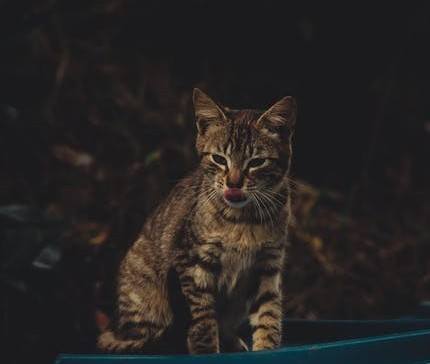
Domestic Cats Do More Than Hunt Mice
The domestic cat – both house cats and ferals – do more than hunt mice. In fact, cats are such good survivors that they domesticated themselves! Human food stores would attract rodents, which in turn, attracted cats. People decided they liked having the cats around protecting their grain stores and encouraged this by feeding them.
One of the biggest differences between wild animals and domestic animals is reward-seeking behavior. Dogs doing tricks to earn treats or attention. To a lesser extent, cats will do the same thing. They learned to survive around human settlements because of the plentiful food source humans provided. They let themselves be tamed.
Domestic felines are opportunistic hunters and very adaptable, which is why feral cats thrive so well. Feral cats, if they do not have a stable food source given to them by humans, will be both an opportunistic hunter of any small animals and they turn scavenger. They can survive by digging in the trash or eating freshly dead animals.
Their acceptance of cat food given by humans is actually a form of scavenging if you think about it. They haven’t caught and killed it themselves. Most predators will scavange if they’re hungry.
A cat’s perfect prey is small rodents, like mice, rats, and rabbits. They will, however, hunt any ground-dwelling animal or even insects! And yes, when an opportunity presents itself, they will hunt birds.

How Do Cats Hunt?
Domestic cats – both pets and feral cats – are solitary hunters. They will not share a hunt with other cats, although if a cat is related or based (or fed) at the same home area, they may end up hunting comfortably in different spots of the same area. Both a genetic relationship and being fed or living at the same location increase cat sociability. However, there has been no coordinated group hunting ever observed in cats. Yet.
As to how exactly they locate prey, our feline companions rely mostly on hearing and sight.
Cats have evolved to hear and respond to the high-pitched sounds that rodents make. Over 20 muscles control their pointed ears. Auditory cues are the most important way cats hunt and cannot be stressed enough. They respond to the higher-pitched sounds that humans and dogs do not hear.
Even young kittens will respond to scratching sounds and high-pitched mouse calls. Adult cats can even locate close prey by sound alone! It’s theorized they can even tell the difference between mice and shrews by the sound they make, too.
That single ability has evolved in cats because their main prey is mice.
Let’s not forget sight, either! After the prey has been located by sound, movement by an object that is not too big or too fast, and moving along a semi-straight path, will trigger a cat to pounce. That said, experienced adults will locate immobile prey easily too, but that is because learning by experience is also important to a cat’s hunting ability.
To put it in more scientific terms, predators can be classified by whether they specialize or generalize the types of prey they catch and by whether they are nomadic or keep a territory. Domestic cats are considered generalists because they can eat many types of prey and often switch back and forth. Domestic cats are also considered resident predators as they aren’t nomadic. But saying that, some scientists have considered feral cats migratory generalists as they do move around switching from different prey to cat food and they will often travel to do so. I personally believe it depends on if a feral cat has a steady food source.
So feral cats are not specialist predators, which are predators who evolved to hunt one specific type of prey. Cats may have evolved to hunt mice the best, but they also can and do catch lizards, other types of rodents and small mammals, birds, and even survive off of human feeding, garbage, and already deceased animals if necessary.
The domestic cat hunts in a couple of different ways. Because of their opportunistic behavior, they often engage in what is called mobile hunting, which is traveling between two barns, for example, until they hear or see prey. They will also use what is called stationary hunting. Basically, sit-and-wait or ambush hunting. Cats also will utilize stalking in their hunting techniques. Sometimes, they will use a combination of these.
Domestic cats do not dig for prey, but they have been occasionally seen entering rabbit burrows to catch young rabbits. But they usually use wait for the animal to emerge so this habit is rare.
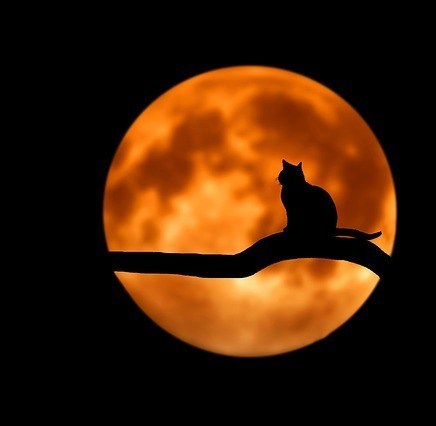
This all depends on the type of prey, likely. For small mammals, they utilize a mobile search and then sit-and-wait. For songbirds, it’s sight and then stalk. For insects, it is sight, then pounce. For larger rodents like rabbits and ground-dwelling birds, they utilize either the sit-and-wait or they will enter the burrow themselves.
Cats are not random hunters, either. They do utilize strategy when choosing a location. Either returning to places they were previously successful or they perform rather thorough searches of potential hunting locations.
When hunting birds, a cat will stalk them slowly (or fast), using cover and other obstacles to hide his approach. The cat will then freeze and stalk closer to the bird until the cat is within pouncing range. It is during these freezing moments that birds will often fly away, without even having seen the cat. The stalking and waiting are more suitable for ground-dwelling prey than birds. Because of the number of failures this causes, a lot of cats will give up on birds completely. Unless they come across an injured or dead bird.
In short terms, hunting birds is a young cat’s game that older, more experienced cats usually abandon unless they find an incapacitated bird. I have personally seen that with barn cats as well. Young ones hunt birds. The older cats will only examine them while they’re grounded.
Bird hunting is too much effort for too little reward. There have been suggestions of cat specializations for specific prey types, like birds, by various authors but no actual field evidence of this.
Scent does not have as much to do with it, although it is thoughts cats might use mouse urine trails to locate burrows, which could be true as even humans can smell this. There has been no documented evidence of this, however.
After a Successful Hunt
Cats have a number of options after capturing prey.
After the prey is captured, a cat may kill and eat it immediately. They may kill it and not eat it. They may bring it back home, dead or alive. Cats may play with it before killing it. They may bring it back home alive for other cats to kill and eat it. Or they can save it for later.
The cats who bring prey back home are often females, with or without kittens, as they do this more often than intact or neutered males. But males will do this as well.
Adult cats are very efficient at dispatching their prey by biting them on the back of the neck, severing their prey’s spinal cord. Quick and relatively painless. Unless they play with it before killing it, of course.
It is often suggested that cats bring humans prey because they see us as some sort of helpless kitten. This might be untrue, however, as male cats have nothing to do with the rearing of kittens. The Domestic Cat: Biology of its Behaviour suggests another reason behind it. Prey brought home is usually because the cat finds itself in a conflict situation.
My cat, Buddy, doesn’t often bring me prey. But when he does, it is because he heard me coming into the barn and he always runs to greet me. As he isn’t hungry, he will simply come to say hello with a mouse in his mouth. This is one example of conflict. Another example is that they don’t want to eat it but don’t want to leave it.
Another theory was during the early years of cat domestication, cats were trained to retrieve game hunted by their humans, much as dogs were.
Yet another theory is that while cats will steal each other’s prey after they set it down, that prey sharing happens more often than previously thought. Perhaps prey stealing isn’t always theft, maybe it is sharing. There have been observations of an adult daughter of a cat with another young kitten that would bring her mother prey.
Perhaps, cats simply see us as part of their family or colony and bring us their kills because of it.
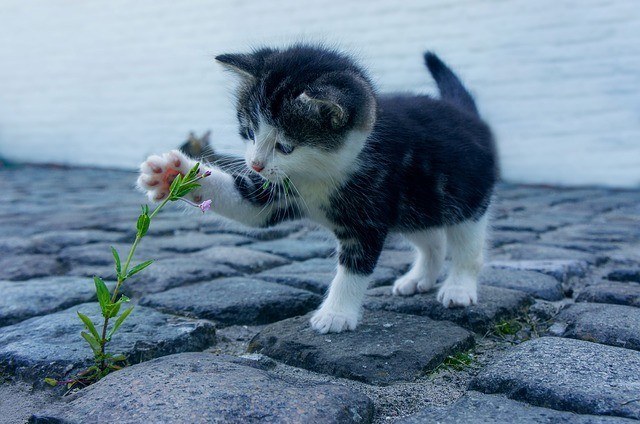
Why Do Cats Play With Their Prey?
There are a couple of known reasons for this and a couple of theories.
Mama cats will bring home prey to their kittens. At first, this prey is already dead. As the kittens get older, Mama will bring them live prey to teach them how to hunt by letting them play with it. It seems cruel, but kittens learn how to catch and efficiently kill prey this way.
Another reason cats play with their prey occurs because of a conflict situation, such as hunger and the size of the prey. For example, when a seriously hungry cat catches a larger and difficult animal, they will often play with it instead of killing or before killing. Perhaps this tires the prey out so that it cannot defend itself as efficiently?
Or perhaps they are not hungry and yet don’t want to let the mouse go, so they play with it instead.
There is the supposed ‘overflow play’ which occurs most often after catching mice. It is theorized that all the tension growing in the cat up until the capture of the mouse then ‘overflows’ into playing with the mouse as a form of tension relief.
Cats Prefer Some Prey to Others!
Biologically and behaviorally speaking, cats are best at catching small rodents like mice and young rabbits.
However, they can catch various species not larger than themselves! The largest prey cats have been known to kill are adult rabbits and hares, and even pheasants and ducks! That said, the larger the prey, the less successful cats are at catching them. You usually only see young cats attempting this.
Various studies have shown cats prefer mice, young rats (which are half-grown) to full-grown rats because these are easier prey.
While cats are very opportunistic hunters, they do tend to prefer some prey species over others. For example, a study in Germany concluded that cats preferred cricetid rodents (hamsters, deer mice, voles, lemmings, muskrats, and New World rats and mice) and rabbits over the murid rodents (Old World rats and mice, gerbils). Murids were also less often found eaten in other European studies.
In North America, apparently jumping mice are rather icky too, as they’ve been caught before but never found in the stomach. Cats also do not favor insectivores such as shrews or moles, but studies in Europe have found rare consumption. There are more cases of cats in North America eating some, though.
House sparrows are caught often by cats, but very rarely eaten, suggesting they don’t taste good either!
When Do Cats Hunt?
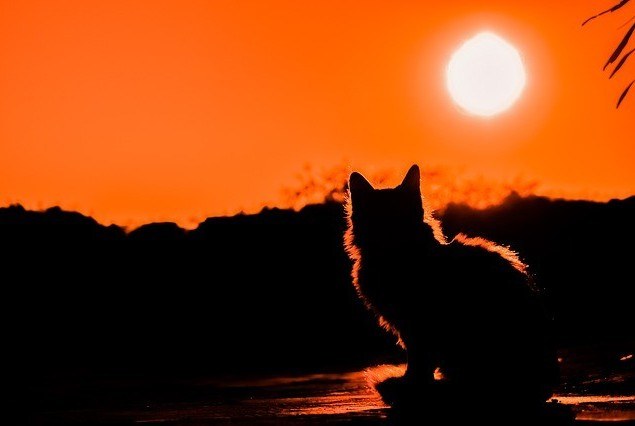
Let us start with the ancestor to our beloved cats, the African wildcat. These beautiful felines are mostly nocturnal and most often hunted at night.
Colony cats, on the other hand, spread their hunting or feeding throughout the whole 24-hour day. Cats are usually thought of as crepuscular (active during twilight hours) or nocturnal (active at night), but that isn’t actually the case in our feline friends. It seems that they adapted to live with us daylight-dwelling (or diurnal) humans!
Cats basically adapt to being active when their food is! If they live with us humans, they start getting active shortly before they’re fed. (That’s why the cat is waking you up at 5 AM.) Then when you get off at work in the evening, they’re back to being active!
If a cat is in an area where they mainly hunt rabbits, they will sleep in the morning, become active in the afternoon, and hunt at night!
Laboratory cats have shown peak activity two times during the night, but they also show them during the day. Some field observations of semi-dependent cats have shown more of a move toward daylight activity instead of nighttime.
In general, cats are more active for longer periods of time during the spring and summer seasons than in winter or autumn. During their active times, cats will also adjust hunting behavior, including adjustments because of the weather. Cats bring home more prey after or before storms, not during.
Cats will also avoid hot mid-day activity in the summer and this I have observed myself. The barn cats here in Louisiana cannot be found from 10 in the morning until 5 in the evening. Unless you are me and feed them nummy food. They will come out if they hear me. But they sleep the hot part of the day away.
Another consideration is that the amount of time a cat spends hunting also varies from cat to cat, between the sexes (intact males don’t hunt as much as neutered males or females), whether they receive supplemental feeding, and social status, believe it or not.
- Cats spend between 0%-46% of 24-hours hunting.
- Well-fed cats spend only around 3 hours a day hunting while feral cats that have no feeder will spend half of their time hunting!
There are many, many variables about cat predation studies that wildlife conservationists are failing to realize. I’m not against wildlife OR conservation. That is part of the reason that I do feed cats and participate in Trap-Neuter-Return (TNR).
- While well-fed house cats and ferals will hunt, almost all will spend LESS time hunting if they are fed. Colony caretakers are helping birds without even trying by reducing their hunting from almost half of the day or almost a quarter of the day.
- By reducing the reproductive capabilities of a colony, and finding homes for existing kittens and strays, you might reduce a colony by 30-40% in one season. That’s fewer cats outside hunting!
- And TNR does eventually eliminate feral cats and the proof is shown in colony size and the reduction of shelter intakes and euthanasia rates. Fewer cats hunting! (Read Does TNR Work in 2019?)
- If the prey population decreases, seasonally or otherwise, the capture rate by cats decreases. Cats adjust their hunting behavior to catch the most abundant prey during their most abundant time. Young rabbits are often the preferred prey in spring when they are emerging. In most areas, birds are hunted in spring and summer when the young and stupid are easily caught, perhaps. Reptiles are also only hunted in warmer months.
- Mother cats are more efficient hunters than males or non-mother females, fed or not. This means fixing cats also reduces predation.
- As cats grow older, they tend to hunt less. Most studies on cats who hunt, the ones with the most successful number of kills were cats under 5 years old.

Where Do Cats Hunt?
Cats often return to areas where they have had hunting success previously, leading researchers to believe cats have a sense of temporal permanence.
In many studies, even cats found in forests don’t usually hunt there and typically prefer hunting in fields and prairies. In fact, males are seen more often in forests than females in Europe, possibly because of their expanded range.
Continental vs. Island Felines
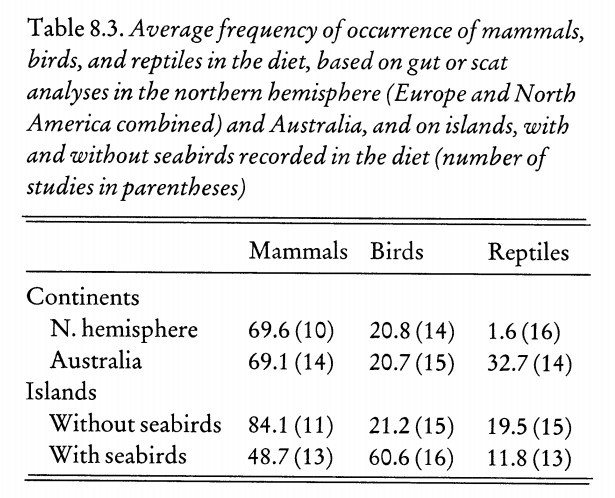
On islands, where rodents and other prey species have evolved without mammalian predators, introduced cats can decimate the population. These rodents have what is called ‘prey naivete‘ and have no understanding of the need to be fearful of cats. Their defenses against predators are practically nonexistent. Thus, easy prey for cats.
This is why studies regarding the diet of cats on continents and the diet of cats on islands are separated.
The Diet of Continental Cats
House cats and feral cats are very hard to tell apart simply by their poo or stomach contents because feral cats may be fed cat food too and house cats hunt.
(These results are all based on different studies around the world that were included in The Domestic Cat: The Biology of Its Behaviour.)
- Country Cats vs. Town Cats: Country cats capture more vertebrates while Town Cats have cat food and insects.
- Town Cats: Outskirts of town cats had more rodent prey, while town cats in the middle of the city took almost NO prey, and cats in between the two extremes took more birds as well as rodents.
- Small mammals are the main source of prey in the domestic cat from numerous studies. (Mammal remains found in cats 33%-90% of the cats)
- Contrary to popular belief, bird remains are only present on average in 21% of cats and only starlings, house sparrows, and pheasants are popular species on continents.
- Of the prey brought home, mammals comprised 64-85%, and birds only 15-36%. (I have observed this myself with barn cats. They very rarely hunt birds.)
- Reptiles can be important prey at low altitudes, especially in Australia.
- Other prey is much less important: frogs and fish are recorded in some cases, at a very low occurrence though.
- Invertebrates are recorded, usually insects but sometimes spiders and crayfish and mollusks, but their significance in a cat’s diet is negligible as it provides little sustenance.
- Carrion is eaten, but it is difficult to distinguish between prey killed by the cat or not, except when it is obviously not possible for a cat to kill (sheep, kangaroo, etc.) Maggots are not an indicator because cats can cache their kills to consume later.
- Unlike many carnivores, cats eat almost no fruit or vegetable matter, only some grass.
Island Cat Diet
- Introduced mammals are a huge part of island cats diets, such as house mice, European rabbits, and various introduced rat species.
- When rabbits are available, they are usually hunted 55% of the time
- Rats being hunted vary between islands and usually depend on whether there are rabbits to hunt. On islands without rabbits, the cat diet consists of 70% rats. On islands with rabbits, rats are only found in 5% of the cats.
- Birds are a much more important diet for cats on islands. On islands with seabirds, they are recorded in 60% of the samples, compared to 21% on islands without seabird prey and continents.
- Species caught on islands are often petrels, penguins, terns, and noddies. In New Zealand and Hawaii, land birds are found much more often.
- Cat populations can thrive on islands with no mammalian prey, where they live exclusively on seabirds and invertebrates.
- Reptiles in samples are comparable to continental data: in lower altitude, there are more reptiles being eaten. Except on islands where there are little reptile populations (Howland Islands).
Effects of Cat Predation on Prey Populations
In some examples, especially on continents, cats are just one of many predators feeding on the same types of prey. Natural history observations are rarely taken into consideration during experiments on cat populations, according to The Domestic Cat: The Biology of its Behaviour.
People are so focused on dividing cat predation into two categories: beneficial or harmful. In fact, some populations of cats are BOTH.
It’s just the sheer NUMBER of cats that are in the United States and elsewhere that causes problems. That’s why controlling their population is SO important!
Beneficial Effects
- Controlling rodents – mice and rabbits, especially, which are both pests to agriculture. Rats, too, but after a large infestation of rats is controlled by other means, cats will then keep rat populations down. Cats rarely eat adult rats, but they will keep young rats from repopulating farms.
- When the cat (and other predators) are reduced or removed from an area, rabbits and rats often explode in numbers, sometimes quadrupling in population in a very short time.
Unknown Effects
- Keep in mind, the presence of game species in cat feces or stomachs does not necessarily indicate a negative effect on the game.
- Very few quantitative studies on the effects of cats have been conducted, it is almost always counting prey in feces and stomachs and brought home, not actually studying the effect cats have on specific populations or experiments with the population increasing or decreasing. All studies should take into consideration the density of the game species, its productivity and its mortality from other sources, and they usually do NOT take those into consideration.
- Predation on songbirds in continental cats is noticed because this usually happens during the day! Most mammals are hunted at night. Plus, these birds are often fed in gardens and such by people, so when a cat preys on one, it is noticed and NOT popular. However, no real attempt has been made to study this effect on songbird populations. In fact, a lot of the birds in Britain that are recovering their populations are common cat prey! It has also been argued by some scientists that cats HELP bird populations by reducing rat and other predator populations in New Zealand.
- There is a lot of complexity involved in the effect of cat predation on the continents. Some worry that cats reducing the population of rodents are indirectly impacting raptors and other birds of prey who also prey on rodents. Yet, if this were the case, these birds would have disappeared LONG ago.
- The REAL concern is on oceanic islands where mammalian predation did not exist until the introduction of cats and other predators. These places have animals with no defense.
- It’s the sheer number of free-roaming cats that is the problem, not whether they exist or not! We need to encourage cat owners to fix their pets, crack down on people who abandon their cats (especially when unfixed, as this is ALWAYS the start to a feral cat colony), and we need to fix the ferals that are already there at the same time as removing kittens and strays into rescues and homes!
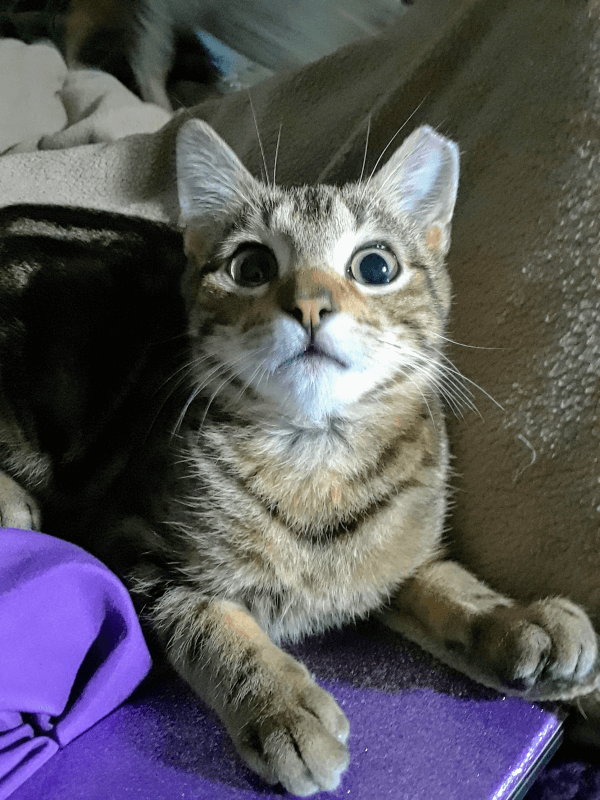
Arguments Against Cat Predation Studies
- One study of a small English village was then extrapolated to the WHOLE of England.
- Most studies get their numbers by prey that is brought home and owner surveys. Not very scientific.
- As house cats get older, the less they will hunt, and this is never taken into consideration when computing estimated yearly predation by cats. The numbers of prey young cats bring in are NOT a representative of the WHOLE population of cats.
- There is a HUGE risk that the surveys conducted of cat owners whose cats brought home prey are likely answered by cats who DO hunt and are unlikely to be answered by cat owners whose cats don’t. Not to mention, it was concluded during one survey that only a few cats brought home the majority of the prey, while the majority of the cats brought home little prey.
- There is not enough actual data to estimate cat predation numbers of birds based on the studies reviewed by cat experts, even though those studies are old and STILL being quoted by conservationists.
- There are few, if any studies outside of island ones, that prove cats affect bird populations.
- There’s too much we don’t know.
- The sheer numbers of feral cats that HUMANS caused are the problem. We need to address the CAUSE of feral cats so we can stop them at the source. It is a sad fact, but even if every single free-roaming cat dropped dead right now, we would be right back where we are now within a few years.
Suggestions that do NOT Reduce Cat Predation
- It has been concluded cats with bells do not bring home fewer prey than cats without bell collars.
- Imposing a curfew on house cats, by bringing them inside at night, will have little to NO impact on birds, which are caught during the day.
Do You Want to Help Reduce Cat Predation?
All of us, even cat lovers, should want to limit the effect cats have on prey populations, especially because of the numbers of feral and free-roaming cats.
- Keep your pet cats indoors! (Unless you adopted a semi-feral cat that doesn’t take to being inside.)
- Spay and neuter your pets to prevent more cats from being born.
- If you feed a colony of outdoor cats, you absolutely NEED to fix those cats. Do not feed them if you don’t plan on taking responsibility for them!
- Trap-Neuter-Return is more than spay and neuter, it is finding homes for adoptable kittens and cats! Get those cats into loving homes!
- If you have outdoor cats, do NOT feed birds, too! And if you feed birds, install cat deterrents around your yard! There are many humane ways to deter cats from your yard.
- Do feed your neutered colony enough food. Don’t keep your barn cats half-starved to encourage them to hunt. They may hunt LESS when full, but they will still hunt those mice.
- Feed your cats more wet and dry food higher in meat! This helps curb a cat’s craving to hunt.
- Play hunting games with your cats with things like feather wands. This helps satisify the need to hunt in cats, according to one study. (Puzzle feeders actually INCREASED the hunting behaviours!)
This was a huge, long post, ladies (and cat daddies!) I hope I was able to educate you on cat hunting behavior and the effect it has or rather how much we don’t know!
Do you have an opinion? Is there a recent study I may have missed? Share below! If you’re interested in cats, I highly recommend reading The Domestic Cat: The Biology of Its Behaviour, Second Edition.
Lovies!

From rats and mice to snakes and spiders our cats have kept our family safe for years and years. They help control as many diseases spread as the risk to them and they do kill birds occasionally but much prefer ground prey. I think they are given a bad name in the loss of birds and are no more a problem in that loss than they are in the loss of the American honey bee. Like you, I see pesticides and habitat shrink being the main killers of these beloved feathered friends.
You obviously know cats if you know they prefer ground prey! I do realize in island ecosystems that are isolated, feral cats can become a problem when they have no natural predators eating the cats, or they’re preying on animals that didn’t evolve protections from predators. But in the US or other places? Yeah, no.
Not to mention, it’s simply mathematics. Their ‘estimates’ are based on small studies with educated guesses they applied to ALL cats. Of which, no one knows for certain how many they are. Younger cats are the ones that tend to go for birds more often than smarter, older cats. Two, if 3 billion birds were eaten by cats every single year in the US alone, which is around 30% of the total bird population of the ENTIRE North American continent, we would not have any birds left!
I DO think that they do have some impact, but the focus on feral cats to blame them is a convenient way to ignore the real problem of habitat loss, climate change, and pesticide use. Easier to blame cats, especially if you don’t like cats, then to admit you are killing birds yourself by supporting farms that use pesticides or adding to greenhouse gases by driving a gas-guzzling SUV or something.
Thanks so much for your comment!
I was always told that cats will bring their humans their catch as a sort of gift. I didn’t know they thought we were their kittens. And it’s funny when you talk about them playing with their pray. My cat once caught a mouse and it seems she played with it for a long time before she finally killed it. I think cats are very interesting and I’m learning a lot by reading your posts.
Thanks for the comment. You’re right that cats will often bring their humans their catch as a sort of gift, but not all cats will. It’s not so much they think we’re their kittens, as some people assume, but that we’re family to them. We feed them, they try to feed us, since you know, they aren’t actually hungry when they kill mice. You’re right that they play a long time.
After reading your site, the first thing I said was “Boy! Here’s a person really into her cats.” It’s a great thing that you do. I guess I’m more of a dog person myself. (My late wife was more into both, cats and dogs. She would have made a great assistant.) I’ve always wondered is all cats considered wild just by nature? Or is it only the strays that become wild with no owner? But with your patience and knowledge in what you do, capturing 40 cats, neutering, vaccinating,then releasing them shows you have a good heart toward animals. Need more in the world like you.
Thank you so much. I’m sorry your wife passed. Thanks again!
Hello there, thanks a lot for sharing this wonderful piece of information here with us. I must say I really did enjoy going through your article as I am a cat lover as well. My cat once caught a mouse and it seems she played with it for a long time before finally killing it. I think cats are very interesting and it’s great learning a lot about this wonderful creature every day. Thanks for sharing this.
Thanks.
This is a question I have asked myself. And it’s interesting to know that a domesticated cat is a obligate carnivore. I will continue researching about this topic. But thank you for giving me this introduction.
I now understand why this has been a heated debate. But I still need a bit more knowledge to take sides.
Thanks for visiting.